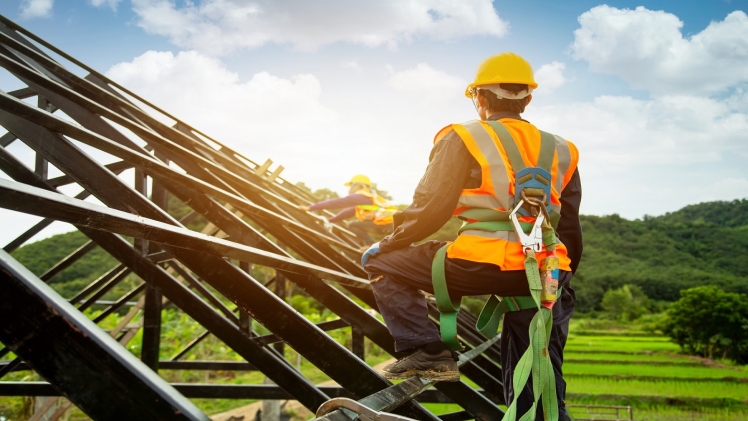Failing to properly manage safety hazards at work increases the odds of your employees suffering both physical and mental on-the-job injuries.
If you want to boost the morale and productivity of your staff, you need to guarantee them safe working conditions.
As we all know, a proactive approach is always better than seeking a remedy after the damage has already been done. So, for that reason, we’ve compiled a list of the 8 most common workplace injuries and things you can do to prevent them.
. Trips, slips, and falls
In 2020, more than one-third of workplace deaths in the construction industry occurred due to trips, slips, and falls.
Among the most common trip, slip, and fall hazards are:
- Working in areas with materials, tools, cords, and other items scattered across the floor where the employees are walking
- Poor visibility in the working environment caused by inadequate lighting.
- Uneven tiles
- Loose floor coverings
- Wet and slippery surfaces
Decluttering your workspace, marking it for unsafe places and securing it against these risks reduces the odds of your employees experiencing work-related sprains, concussions, fractures and injuries alike.
. Overexertion and muscle strains
If your employees are fatigued, they’re more likely to experience an on-the-job injury.
If your jobs consist of the following, you need to take measures against employee overexertion and muscle strains:
- Frequent lifting
- Pushing
- Pulling
- Carrying the heavy load
- Performing repetitive motions
- Standing in place for too long
These measures can include frequent breaks at work, training your employees in safety practices when handling heavy objects, limiting manual lifting to equipment under 50 lbs, providing comfortable furniture, and introducing task rotation.
. Contact injuries caused by other employees, equipment or falling objects
Jobs that require employees to work with heavy machinery are known to have an increased risk of injuries caused by employees being hit, run over, or crushed by the moving machinery.
If your machines aren’t safely guarded or if your employees aren’t trained to stay aware of their surroundings, they might be at risk of severe breaks, head injuries, blindness, and more.
For that reason, it’s important to have safety policies and protective equipment in place to ensure that workplace safety is a priority for your business.
. Crashes and collisions caused by vehicles
Although car accidents are the most frequent transportation accidents leading to workplace injuries, these injuries can also be caused by trains, faulty railways, unrestrained animals, airplanes, boats, motorcycles, bicycles, and any other vehicle.
As a business owner, you’re liable for any injuries your employees suffer while driving these vehicles for the sake of their employment.
There are, however, safety measures that you can take to minimize the risk of crashes and collisions during work-related transportation.
For one, you can introduce a mandatory seatbelt policy, test for alcohol use, regularly maintain vehicles and forbid mobile phone use. Hiring a good driver in the first place helps, too!
. Exposure to the harmful work environment and hazardous substances
Protecting all of your senses from a hazardous environment is extremely important.
Whether you’re working in spaces with high temperatures, radiation or noise levels, you need to ensure that your exposure to these harmful conditions is limited.
Make sure that your employees are properly protected against toxic chemicals to avoid contracting diseases and causing irreparable damage to their organs.
Require them to wear protective equipment, store harmful substances in safe containers, and ensure proper ventilation in your work environment.
. Workplace violence and other injuries
A significant number of workplace injuries occur due to employee-on-employee. For that reason, monitoring the behavior of your employees for changes is incredibly important.
Watch out for warning signs, such as:
- Emotional outbursts
- Suicidal, bullying, or inappropriate comments
- A sudden drop in job performance
- Other violations of policies at work
In situations where your employees are intimidated, harassed or assaulted by other employees, it’s best to involve an HR specialist and/or a lawyer to protect your workers and your business.
Interested in the results of involving a lawyer in work-related injuries? Learn more here.
. Explosion and fire-related injuries
Although explosion and fire-related injuries aren’t that common, when they do occur, they have the destructive potential of permanently incapacitating your employees.
Depending on the level of the blast, injuries to your employees may range from burns, through collision-induced injuries to serious lung and other internal organs damage.
It’s important to limit employee exposure to flammable substances and explosive atmospheres, as injuries suffered from these accidents can lead to extremely high workers’ compensation insurance costs.
. Mental injuries
Physical injuries aren’t the only ones your employees can suffer on the job.
We’ve already briefly mentioned suicidal thoughts, which can lead to workplace injuries and are often caused by work-related stress. Apart from that, poor working conditions and organization can lead to your employees feeling isolated, anxious, mentally drained, and depressed.
To prevent psychological injuries at work, make sure to perform regular risk assessments, initiate conversations about the mental wellbeing of your employees, and develop a stress-prevention policy. Spaces that are cluttered and messy tend to increase employees’ stress levels, thus reducing their productivity. To ensure your work space is clean, you’ll need to get rid of unnecessary papers. If your work space is located in a large city, there are many companies that can help keep your space clean. By scheduling a secure paper shredding service in San Francisco, for example, you can make sure your office space is as tidy as possible. A clean workplace not only reduces stress levels, but it also gives a good impression to clients, improves efficiency, and leads to better collaboration.
By providing support to your employees, you’re ensuring a positive business culture, higher productivity, and efficiency.
Conclusion
Before your business starts operating and your employees start working, make sure that you have sound regulations and policies regarding safe working conditions in place.
Keep in mind that preventative measures are always a better option than treating an issue once it arises. Holding this stance will not only protect your employees, but also ensure that your compensation costs are kept at a minimum.
However, if your employees do end up getting hurt at work, it’s best to get the HR and a lawyer involved before the situation escalates any further.




